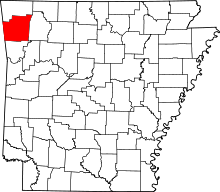Elm Springs, Arkansas
| Elm Springs, Arkansas | ||
|---|---|---|
| City | ||
| ||
 Location in Washington County and the state of Arkansas | ||
| Coordinates: 36°12′27″N 94°13′17″W / 36.20750°N 94.22139°WCoordinates: 36°12′27″N 94°13′17″W / 36.20750°N 94.22139°W | ||
| Country | United States | |
| State | Arkansas | |
| Counties | Washington, Benton | |
| Founded | 1832 | |
| Incorporated | May 23, 1917 | |
| Government | ||
| • Type | Mayor/Council | |
| • Mayor | Harold Douthit | |
| • Chief of Police | Jason Hiatt | |
| Area | ||
| • Total | 5.991 sq mi (9.868 km2) | |
| • Land | 5.76 sq mi (9.27 km2) | |
| • Water | 0.231 sq mi (0.598 km2) | |
| Elevation | 1,184 ft (361 m) | |
| Population (2010) | ||
| • Total | 1,535 | |
| • Density | 274.7/sq mi (106.5/km2) | |
| Time zone | Central (CST) (UTC-6) | |
| • Summer (DST) | CDT (UTC-5) | |
| ZIP code | 72728 | |
| Area code(s) | 479 | |
| FIPS code | 05-21430 | |
| GNIS feature ID | 0076873 | |
| Website | www.elmsprings.net | |
Elm Springs is a city in Benton and Washington counties, Arkansas. The community is located between the Boston Mountains and the Springfield Plateau within the Ozark Mountains. Initially a community surrounding a spring-fed mill, the community flourished even after the mill's destruction during the Civil War.
Located immediately west of Springdale in the Northwest Arkansas metropolitan statistical area, Elm Springs has been gaining population in recent years, including a 47% increase in population between the 2000 and 2010 censuses.[1]
Geography
Elm Springs is located at 36°12′27″N 94°13′17″W / 36.20750°N 94.22139°W (36.207590, -94.221515).[2]
According to the United States Census Bureau, the city has a total area of 5.991 square miles (15.52 km2).
Demographics
| Historical population | |||
|---|---|---|---|
| Census | Pop. | %± | |
| 1930 | 182 | — | |
| 1940 | 156 | −14.3% | |
| 1950 | 217 | 39.1% | |
| 1960 | 238 | 9.7% | |
| 1970 | 260 | 9.2% | |
| 1980 | 781 | 200.4% | |
| 1990 | 893 | 14.3% | |
| 2000 | 1,044 | 16.9% | |
| 2010 | 1,535 | 47.0% | |
| Est. 2015 | 2,147 | [3] | 39.9% |
2015 Estimate,[5] Encyclopedia of Arkansas History and Culture | |||
As of the census[6] of 2010, there were 1,535 people, 527 households, and 439 families residing in the city. The population density was 276.9 people per square mile (106.9/km²). There were 577 housing units at an average density of 108.7/sq mi (42.0/km²). The racial makeup of the city was 87.4% White, 1.2% Black or African American, 1.4% Native American, 2.9% Asian, .2% from other races, and 1.4% from two or more races. 8.5% of the population were Hispanic or Latino of any race.
There were 527 households out of which 37.2% had children under the age of 18 living with them, 71.9% were married couples living together, 6.5% had a female householder with no husband present, and 16.7% were non-families. 16.7% of all households were made up of individuals and 4.7% had someone living alone who was 65 years of age or older. The average household size was 2.91 and the average family size was 3.21.
In the city the population was spread out with 26.7% under the age of 18, 7.7% from 18 to 24, 24.2% from 25 to 44, 30.4% from 45 to 64, and 11.5% who were 65 years of age or older. The median age was 39.7 years. For every 100 females there were 103.3 males.
In 2000, The median income for a household in the city was $40,703, and the median income for a family was $45,536. Males had a median income of $30,550 versus $20,000 for females. The per capita income for the city was $17,551. About 8.6% of families and 12.5% of the population were below the poverty line, including 19.8% of those under age 18 and 5.0% of those age 65 or over.
Churches
Elm Springs Assembly of God, Elm Springs United Methodist Church, Faith Regular Baptist Church
References
- ↑ Teske, Steven (January 17, 2013). "Elm Springs (Washington and Benton Counties)". Encyclopedia of Arkansas History and Culture. Butler Center for Arkansas Studies at the Central Arkansas Library System. Retrieved July 7, 2013.
- ↑ "US Gazetteer files: 2010, 2000, and 1990". United States Census Bureau. 2011-02-12. Retrieved 2011-04-23.
- ↑ "Annual Estimates of the Resident Population for Incorporated Places: April 1, 2010 to July 1, 2015". Retrieved July 2, 2016.
- ↑ "Census of Population and Housing". Census.gov. Retrieved June 4, 2015.
- ↑ "Annual Estimates of the Resident Population for Incorporated Places: April 1, 2010 to July 1, 2015". Retrieved June 26, 2016.
- ↑ "American FactFinder". United States Census Bureau. Retrieved 2008-01-31.


